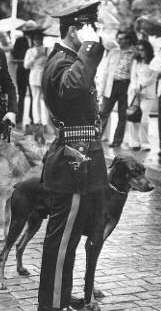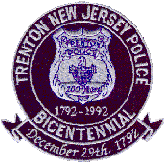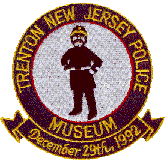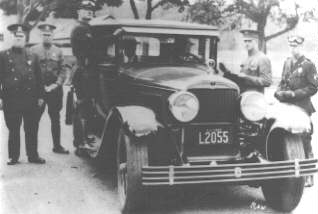TRENTON POLICE MUSEUM

1920 - 1939

Historic Synopsis
1920's
The 1920ís began with what was perhaps the largest mistake ever made by the United States. In January 1920, the 18th Amendment to the Constitution was enacted, making illegal the sale, importation and consumption of liquor. Prohibition, as it was known, would last until December 1933. Out of Prohibition was born the illegal liquor trade and terms such as "Rum Runner", "Bootlegger" and "Speak Easy" became part of everyday vocabulary. Organized Crime groups (or Families) were the prime benefactor of Prohibition and prospered by supplying the liquor and by employing murder, intimidation, extortion and bribery as their main tactics. Trenton was not immune to the presence of Organized Crime. In fact the opposite is true. Being located almost mid-way between New York City and Philadelphia caused Trenton to witness a rise in Organized Crime like few other cities of its size would see. The increase in the sale of illegal alcohol, led to the formation of the "Dry Squad", whose primary duty was to investigate "Speak Easys". The number of "Speak Easys" operating in Trenton was hotly contested at the time. Chief Walter had his own estimate as to the number...
|
*NOTE: Trenton is only 7.5 square miles in size.
Headline in the Trenton Times,
November 20, 1932.
Walter scoffs at 3,200
Trenton Speakeasies;
Only 800 He Claims
Quote attributed to
Chief William P. Walter
|

1930's
As the 1920's grew to a close, the country was rocked by another event. In October of 1929, the Stock Market crashed. The Great Depression had begun and would last 10 years, with the worst years to be 1933-1935. Trenton struggled to cope with the economics of the time and the city budget was reduced. The Police Department and other sections of the government were forced to take pay cuts. (See table)
|
** The pay cut percentage was the same for all ranks
| YEAR |
PAY
CUT** |
PAY-SHIFT
CHIEF |
PAY-SHIFT
PATROLMEN |
| 1932-33 |
5% |
$4,400 - $4,180 |
$2,400 - $2,280 |
| 1933-37 |
20% |
$4,400 - $3,520 |
$2,400 - $1,920 |
| 1937-38 |
15% |
$4,400 - $3,740 |
$2,400 - $2,040 |
| 1938-39 |
5% |
$4,400 - $4,180 |
$2,400 - $2,280 |
|
Sadly, the elements present in the 1930's (The Depression, Prohibition & Police Pay Cuts) led to corruption in the department. The large sums of money which Organized Crime had available for bribes tempted many officers and public officials. Newspaper articles of corruption and scandals were all too common causing the public to lose trust in the Police. The public loss of faith in the department was expressed very often with published "Letters to the Editor" in the newspapers. The corruption continued even after the repeal of Prohibition and extended to loan sharking and gambling operations. It is important to note that the corruption was not total, there were many officers who chose not to partake in the accepting of bribes. A few even had the courage and conviction to speak out against the corruption.
All that happened in the 1930's was not bad. On June 1, 1936, the department made a major technological advance, when radios were first installed in Patrol Cars. No longer were call boxes the only means to communicate with officers on patrol.
|

Gallery

| First Precinct, Police Headquarters |
|---|
| circa early 1920's |
|
A horse drawn delivery wagon, delivery truck and Police car are parked on Chancery Lane in front of Headquarters. A closer look at the Police car (last in line) shows the running board mounted siren.
|

| Trenton & Pennsylvania Officers |
|---|
| 1920 |
|
Trenton officers stand with officers from Pennsylvania. The Patrol Car, with its single red flashing light mounted on the hood in front of the driver, is a Trenton Police car.
|

| Trenton Motorcycle Officers |
|---|
| 1922 |
|
Trenton officers stand in front of the Battle Monument, located at the intersection of five major thoroughfares of the time. The use of Motorcycles as Patrol vehicles was quite common up into the 1960s. Though Patrol cars and wagons were still needed to transport prisoners and manpower, motorcycles allowed for rapid response times, with a minimal expense.
|

| Slot Machines |
|---|
| June 20, 1928 |
|
Seized during a gambling raid, the slot machines are secured in the stables at Police Headquarters. With Prohibition came the insurgence of Organized crime, which in turn spawned an increase in illegal gambling. These slot machines were seized during the raid of a city "Speak Easy".
|

| Slot Machines |
|---|
| June 21, 1928 |
|
The day after the Slot Machines were seized, they were destroyed.
The rules of evidence not being what they are today, to say the least.
|

| Patrolman William Winston |
|---|
| circa 1932 |
|
Patrolman Winston was hired in on June 1, 1932, he walked a foot post in the First District until August 23, 1964, when he raised to the rank of Detective. Winston retired on April 24, 1971, with 39 years of service.
|

| Traffic Officers |
|---|
| 1936 |
|
Men of the Traffic Division stand at the front of the First Precinct with their "motorbreeches" (pants) tucked into their riding boots (used by Motorcycle Cops), and their straight bottom neck-ties.
|

| "Radio Patrol Cars" |
|---|
| circa 1937 |
|
On June 1, 1936, the department made a giant technologic step forward when six of the Patrol Cars in the fleet had two-way radios installed. In a 1937 poster distributed around the city, the department boasted an average response time of 2 minutes to the nearly 5000 calls handled since the radios were installed.
|

| Police Radio Patrol |
|---|
| circa 1937 |
|
Here an officer talks on the radio in one of the newly equipped cars. Notice the insignia on the door. Radio equipped Patrol cars were known as "Police Radio Patrol" cars.
|

| Motorized Patrol |
|---|
| circa 1937 |
|
Motorized patrol was becoming common in Trenton, however the old fashion Foot Patrol lasted into the 1990's and surely will return one day.
|

| Trenton Police Academy |
|---|
| circa 1936 |
|
Officers attend an in-service training class at the Trenton Police Academy. Training was as important in the 1930's as it is today, and the department recognized that importance.
|

Table of Contents
[ MUSEUM HOME PAGE |
DEPARTMENT HOME PAGE ]
Persons have ANY materials relating to the history of the
Trenton Police Department, are requested to Click Here.
Direct questions or comments to historian@tpdhistory.com
©1997, 1998, 1999, 2000, 2001, 2002, 2003 by M. Crosby Click here for more copyright information Click here for more copyright information
|












